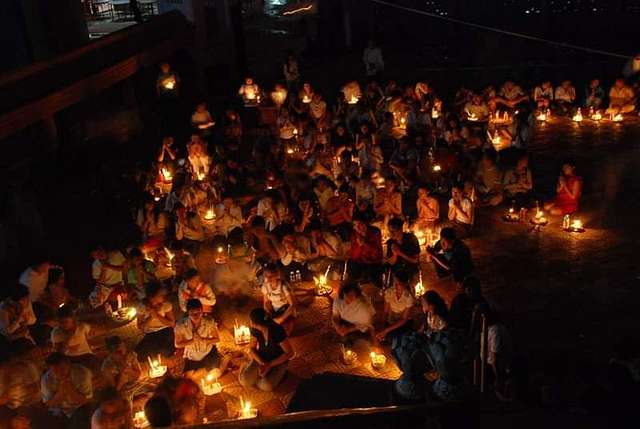Ben Pchum or Pchum Ben is a big ceremony that Buddhists in Cambodia hold every year since before the Angkor Era. It is also the longest ceremony in Cambodia, taking up to 15 days between September and October. According to the Book of Customs & Traditions, there are two stages of the ceremony. The first stage is Kan Ben which is from the 1st to the 14th Roaj of the Khmer lunisolar calendar. And the second stage on the 15th Roaj which is the biggest and final day known as Bun Pchum. People get 3 days off on the final 3 days so that they can visit their hometown and go to the pagodas.
Before we get to the ceremony, let’s talk a bit about the Khmer lunisolar calendar. We count the day by the moon phase with Kert which signifies the waxing phase and Roaj which starts from full moon to new moon. Simply put, Kert is when the moon begins to get brighter until full moon and Roaj is from full moon to a new moon. You will understand why I have to go through the moon phase once we get into the background of the ceremony. Let’s dive deeper into this ancient tradition of my culture below.
Who Is The Ceremony For?
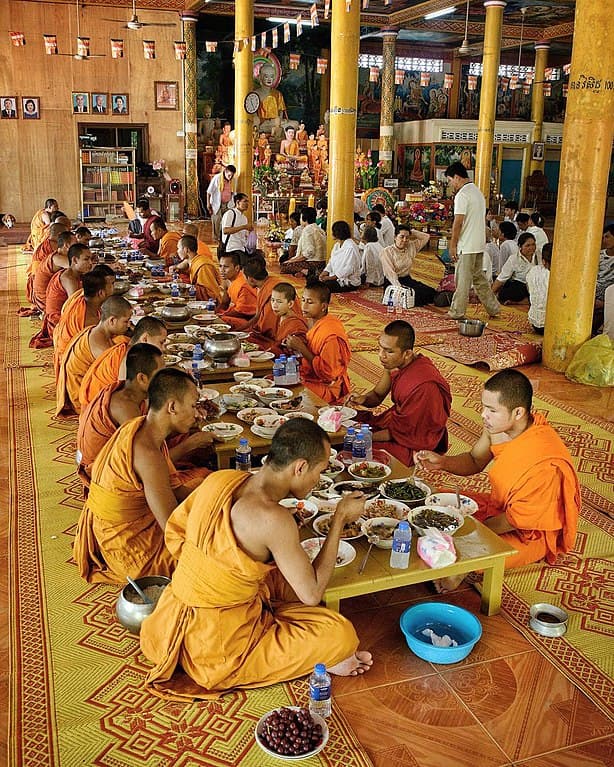
In our culture, we believe that the afterlife of those who passed away depends on the sins they committed when they were alive. If they were good people who did good things and were kind, they would reincarnate in a good family or go to heaven. While the bad people who did bad things will become one of the 12 Preta (hungry ghosts) in hell. The purpose of the ceremony is to dedicate food to the deceased ancestors and family members of 7 generations.
Growing up, I watched short story videos about what we believed would happen during Pchum Ben Day. If we go to the pagoda to dedicate the offerings to our ancestors, they will bless us with good words. However, the hungry ancestors who did not receive any food after looking for offerings from up to 7 pagodas will become angry and curse them. Another belief is that our ancestors will bless us with good things for the whole year if go to 7 pagodas. This is also why we have a saying, “Doing this or that is like going to 7 pagodas.” which means it is a big blessing in life. True or not, I do not know.
Preta
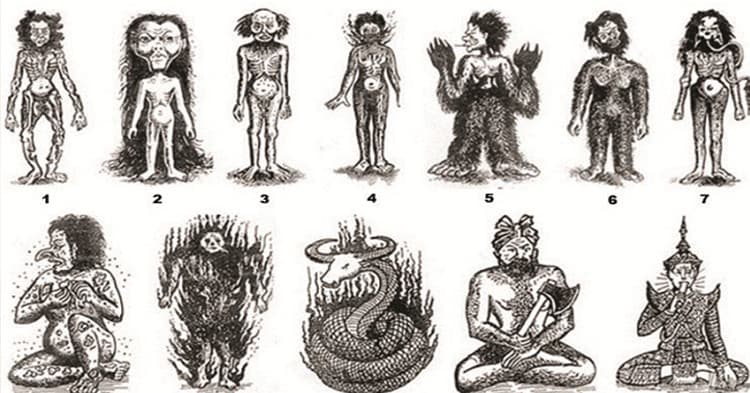
There are 12 types of Preta in Cambodian belief including:
Vun Teas Preta
It has bulging eyes, grumpy face, hairy head, unproportionate mouth, hunchback, curly hair, bulging breasts, and lanky body full of scabs. It has a strong stench and it feeds on people’s saliva and mucus. This Preta did not do good things purely from the heart and it spits in people’s food when it was human.
Kona Basa Preta
It has a saggy belly, tiny face, huge eyes, long chin, huge teeth, and hair so long it drags on the ground. This Preta smells horrible and it only consumes corpses. The more it eats, the more hungry it gets because of the sins it committed.
Kootha Preta
The Preta’s eyes are hypertropia, and its lips are so upwards the teeth are shown. It has a big head with just hair on the sides while the neck is so short like a bullfrog. Its body is so skinny and the belly is big while its hands and feet are abnormally large. This Preta feeds on excretion because of the sins as an unkind and rude person when it was alive.
Aki Jealakmuk Preta
Aki means fire, and this Preta has fire burning in its mouth and on its body. The eyes are bulging while the burning mouth is extremely painful so it cries all the time. It is on fire all day and night so its skin is full of blisters and burning wounds. This Preta is a cursed one because it was a playful person who made fun of the monks. It lives deep in the forests, near the sea, or on the rocks, always hungry and thirsty but can never eat.
Sojekmuk Preta
This Preta has a tiny mouth like a needle tip while the head is large with bulging eyes. It has large hands and feet with rotten nails, and the head and beard are very long. The previous life of this Preta was a wealthy yet stingy person who never helped the poor or their own parents. It is always hungry but the tiny mouth does not allow it to eat or drink anything.
Tonahakdith Preta
This is a huge and tall Preta with large hands and feet with hair and moss all over its body. It has a long bent neck, crossed eyes, big nose, saggy lips, huge teeth, and big belly. This Preta lives far away from the others, and whatever it eats or drinks turns into stones so it is always hungry.
Sonichheamokak Preta
This Preta was completely burned so it is very dark in color, and it has a tail for a mouth. It looks extremely hideous with a big belly with an outward belly button, hairy, and lanky. The smell is unbearable and it has broken ears that fall on its shoulders. This Preta lives in deep jungles or on an island by itself because it is cursed. The curse is from its mocking remarks towards the monks and other people.
Sothongak Preta
This one has knives for fingers, and it has rotten scabs and blisters full of fly eggs all over its body. Bulging eyes, long big nose, saggy belly, and smell horrible. It cries out in pain because of hunger and it uses its knife-like fingers to scratch itself to feed on its own flesh. This Preta abused its parents and insulted its grandparents or ancestors, and it was an ungrateful being. The heavy sins make it hungrier the more it eats because it was an unkind person when it was alive.
Bopatong Preta
With a body like a mountain, this Preta has short limbs, a long body, small head, and short neck. The skin is as tough as an elephant’s skin, and it is always on fire. It is always hungry because it was a vengeful person who always wished the worst on others. This Preta is always hungry but never dies and it has to suffer for billions of years.
Achakurong Preta
Probably the strangest one, this Preta has the body of a python but a head of either a python, tiger, cat, cow, or buffalo. Its long body is on fire all day and night, and it is always hungry. This Preta lives on the rocks in deep jungles or mountains near the sea. It did not do anything good in its previous life, and it disrespected the elderly by saying they were animals. This Preta also insulted the monks and that is why it has a burning animal form like this.
Vimeankak Preta
The previous life of this Preta was a combination of good and bad deeds but in an insulting way. It has a large and stocky body with a big belly, and it has weapons in its hand. This Preta is called Yamaraj (the king of devils), and it kills animals in hell from morning to evening. It does not eat and it has the power to control and interrogate anyone in hell. In leisure, it becomes a divine being with the perfect look loved by angels. When suffering, it becomes the Preta that suffers all day and night.
Mohithakak Preta
Lastly, the Preta with the most authority that watch over other Preta. It has a very pleasant appearance with proper attire but it is always hungry. Any food it touches will be on fire. Even if it is fast enough to put in its mouth, the food becomes a hot steel that burns its mouth. While looking good, its smell is extremely horrendous. In its previous life, it was a monk but it did not respect the religion. It just became the monk for the sake of food but it committed bad sins and lied to the people.
What Do We Do?
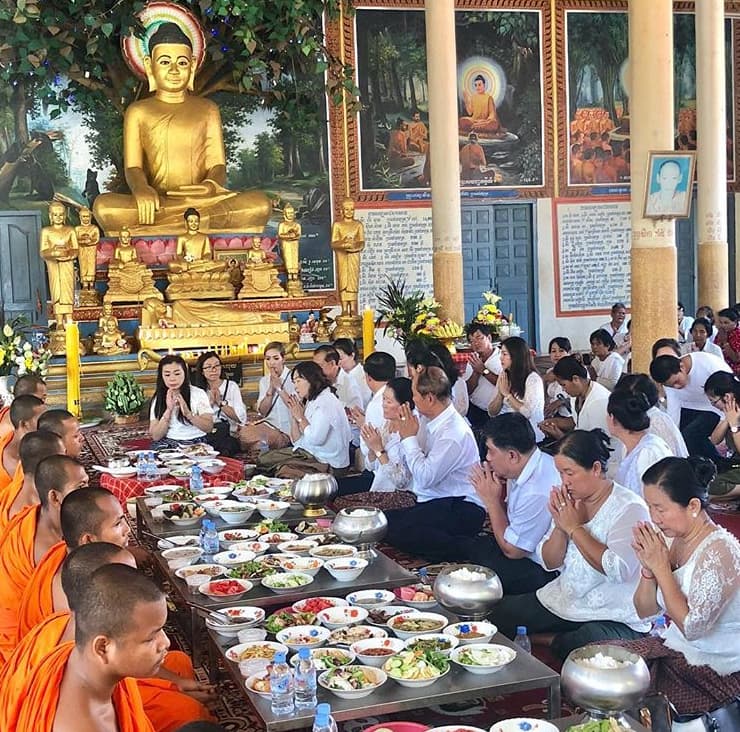
Traditionally, people go to the pagoda at 4AM to throw Bay Ben (rice balls). These rice balls are specifically for the ancestors who became Preta when they passed away. They are also for the lonely Preta without relatives to dedicate any food for them. Why do we have to get up so early? Preta cannot be exposed to bright lights, and 3AM-4AM is the darkest time when they can come out to receive the rice balls. This is also the reason why we hold Pchum Ben day in Roaj months because the moonlight is dark. People before went to sleep very early, especially farmers and those who live in rural areas. By 7PM, people already turned in and they would still have to get up early in the morning to go to the rice fields anyway.
We don’t just throw the rice balls anywhere they want, there are specific places. The tradition allows people to throw the rice balls as they walk around the monastery. That means the rice balls are within the perimeter of where they walk. We are not allowed to throw rice balls outside the pagodas because some bad Preta can harm us. You might not believe this but there have been many stories of people seeing Preta during Pchum Ben. I might translate a few good ones for you in the next articles. This is the perfect time to read some ghost stories since Pchum Ben is in 3 months.
What Is Bay Ben?
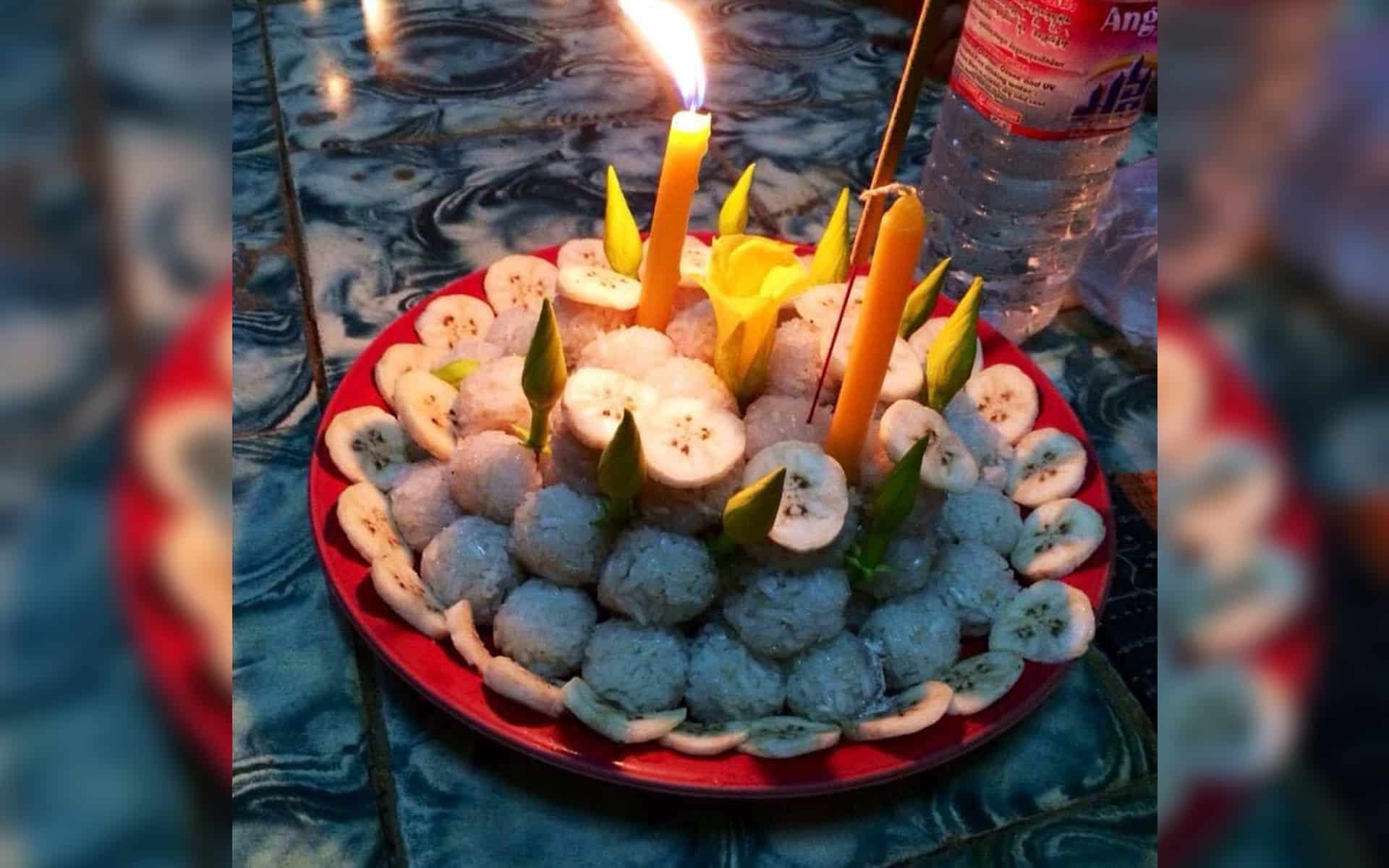
Bay Ben is a collective word for rice, food, fruits, and desserts on just one plate. Before going to the pagoda, some people also gather at a relative’s house and chip in food they can. So there could be many different things in just one plate that people can dedicate to their ancestors. Then they will light the candle and incense, and pour water while asking the spirits of the ancestors to receive the offerings. The grandmas usually bring Bay Ben to the pagoda while the young ones cook at home.
The food that the people bring to the pagoda is usually put around the monastery for the ancestors. As for the rice balls, people randomly throw them to dark places as they walk around the monastery for Preta without relatives. Bay means rice in Khmer, and Ben actually refers to the rice that we offer to the monks. People in some areas don’t even call it Bay Ben, they call it Bay Preta because it is for Preta.
Is it a waste to throw so many rice balls like that? No. Bay Ben is made from glutinous rice that we use for making desserts. Do you know that glutinous rice is sticky and it makes us full fast? Our ancestors used this type of rice to make Bay Ben because it is not expensive and it makes Preta become full fast. That also helps with the market of glutinous rice, and sellers are happy with the good sales too.
What Is Kan Ben?
As I mentioned in the introduction, Kan Ben is the first 14 days of the ceremony. We call each day Ben 1, Ben 2, Ben 3, up to Ben 14. The real question is why are there so many days to celebrate this religious ceremony? From what I know, we believe that the gate of hell will be opened for 15 days for Preta to come to the living world. During those days, they will get to receive food from their relatives and offspring. And this is also why the ceremony is on the rainiest days of the rainy season. That way, the nights are always dark and they can seek food and waste to feed on.
What Is Ben Pchum?
Before, Ben Pchum was the second stage that was celebrated just one day. Pchum comes from the word “Bror Chum” which means gather together. So going to Ben Pchum simply means gathering together to offer food and other offerings at the pagodas. Now, we celebrate the last 3 days with the 15th day as the biggest day instead. People are getting busier with work, especially those who live in the city so they usually wait for the national holidays. It is also a wonderful idea from our ancestors to gather family members to come together at least once a year. Since Buddhism is our national religion, we get 3 days off to visit family members or go to the pagodas together with family.
On Pchum day, the pagoda will hit the drum at 4AM from slow to fast to mark the beginning of the ceremony. The monks start to chant the mantra while the elderlies prepare food and offerings. For people at home, they also get up early in the morning to prepare food. People dress in traditional clothes and carry food to the pagoda. It is a tradition to bring Nom Ornsom and Nom Kom as they are one of the most common desserts/snacks.
When the sun rises, people begin to Roib Bart (offer food to the monks), making the ceremony absolutely lively. The monks continue chanting the mantra while everyone gathers to listen and pray. It takes around an hour, and there will be plenty of food, fruit, and Nom Ornsom that everyone will eat after. We always joke that pagoda food tastes the best on Pchum Ben, and it is from the atmosphere and the lively crowd.
Ancestor Farewell Ceremony
In the evening of Pchum Ben day, people also prepare another tray of food at home at around 5PM-6PM. It is like the last meal for the ancestors right in the comfort of their homes before going back. Along with that, people also prepare another small tray of food for the two guards of hell (យមទូត). We call them the black ghost and white ghost who are the guards of the souls that we invite to eat at our home. The offerings for the guards include: chicken heads, bacon, salted eggs, a small bowl of salt, and a cup of rice wine. While it is the tradition, not many people are doing it now, especially those who are in the city.
Preta’s Cry
This is the recital that people always play during Pchum Ben Day. The recital describes the pain and sorrow of parents who passed away and then became Preta. Its purpose is to tell people to know what to do on this ceremony so that their deceased parents won’t be suffer with hunger. The recital is satisfyingly eerie, especially when played early in the morning.
Bang So Kol & Sand Mountain Ceremonies
Bang So Kol (ពិធីបង្សុកូល) is a ceremony where people dedicate good deeds to the souls of the dead. The souls include those of their relatives and even animals they killed to be free from their sins. It is one of the ceremonies that some people do at the pagoda or at home.
Sand Mountain (ពិធីបំបួសភ្នំខ្សាច់) is another important ceremony during Pchum Ben. Traditionally, people carry sand to make a pile with the shape of a mountain at an acceptable height and size. Then they will bury a clay pot on the top of the sand mountain, leaving just the mouth. People then shaped the sand mountain with a design just like a stupa that represents the Buddha’s stupa.
Sources Wikipedia Wikepedia (Khmer) Kampucheers
Related Post: Funerals In Cambodia
